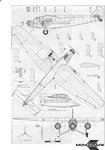I noticed that a lot of Italian designs and some German designs of 1930's origin and later bore three engines, not sure why this configuration was so popular. More drag, more frontal area, more expensive to build, more resources and more complexity than a twin; less powerful or effective than (an admittedly larger and more complex) four-engined design on paper, etc.
Sure some were effective airplanes, I happen to like the SM.79 a lot (which for a while was the fastest medium bomber in the world) but they didn't really do anything a twin with more powerful engines couldn't do. I guess the redundancy of an extra engine is helpful but there's fuel consumption to worry about too and frankly in your average medium-sized bomber or transport if you're in a situation that knocks it down to one engine it seems like you'd have much bigger problems than just staying airborne.
Any thoughts on this? Do you think the Germans and Italians would've been better served in WWII by binning tri-engine designs and using the resources for more efficient twins? Discuss.

Sure some were effective airplanes, I happen to like the SM.79 a lot (which for a while was the fastest medium bomber in the world) but they didn't really do anything a twin with more powerful engines couldn't do. I guess the redundancy of an extra engine is helpful but there's fuel consumption to worry about too and frankly in your average medium-sized bomber or transport if you're in a situation that knocks it down to one engine it seems like you'd have much bigger problems than just staying airborne.
Any thoughts on this? Do you think the Germans and Italians would've been better served in WWII by binning tri-engine designs and using the resources for more efficient twins? Discuss.

